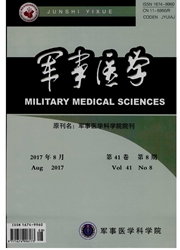

 中文摘要:
中文摘要:
目的:探讨HIV-1 Tat蛋白对细胞周期相关基因表达以及电离辐射诱发细胞周期阻滞的影响.方法:使用包含102个与DNA损伤修复和细胞周期相关的基因微阵列检测人横纹肌肉瘤细胞(TE671)及已转染tat基因的TE671细胞(TT2)基因表达谱的改变;使用流式细胞仪检测细胞周期变化;Western印迹检测蛋白表达变化.结果:在基因芯片的检测中发现,与DNA损伤修复及细胞周期调控相关的6个基因Cdc25C,KIF2C,Cdc20,DNA-PKcs,CTS1,Wee1在转染tat基因的细胞中表达下调;细胞周期检测发现TE671细胞和TT2细胞经4 Gy γ射线照射后表现出不同程度的G2/M期阻滞,但表达Tat的TT2细胞G2/M阻滞出现较TE671细胞晚,而在照射后48 h时TE671细胞G2/M期阻滞已恢复,但TT2细胞阻滞仍很显著.另外,TT2细胞S期阻滞时间延长.研究进一步发现细胞周期蛋白(cyclin)B1在TT2细胞中表达增强.结论:HIV-1Tat蛋白导致G2/M检验点功能紊乱,将影响细胞的辐射敏感性,本研究为了解AIDS合并肿瘤患者对放射治疗敏感性提供了重要实验数据.
 英文摘要:
英文摘要:
Objective: To explore effects of HIV-1 Tat protein on the expression of cell cycle-related genes and cell cycle arrest induced by ionizing radiation. Methods: A human rhabdomyosarcoma cell line TE671 and TT2 cells generated from TE671 cells by transfecting with tat gene of the HIV-1 strain were employed. Microarray,which contained the oligonucleotide probes corresponding to 102 human DNA damage response related genes, was used to analyze transcriptional changes. Cell cycle changes were analyzed by flow cytometry. Results: Microarray assay demonstrated that cell cycle-related genes Cdc20, Cdc25 C, KIF2C, CTS1 and Weel were down-regulated in Tat-expressing TF2 cells. Tat-expressing cells ex- hibited a noticeable delay of the initiation and elimination of radiation-induced G2/M arrest and a prolonged S phase arrest as compared with parental cells. Moreover, overexpression of cyclinB1 was also observed in Tat-expressing TF2 cells. Conclusion: Dysregulated cell cycle checkpoint in Tat-expressing cells can provide new information for understanding the radiation responsiveness of AIDS patients with cancer to radiotherapy.
 同期刊论文项目
同期刊论文项目
 同项目期刊论文
同项目期刊论文
 期刊信息
期刊信息
